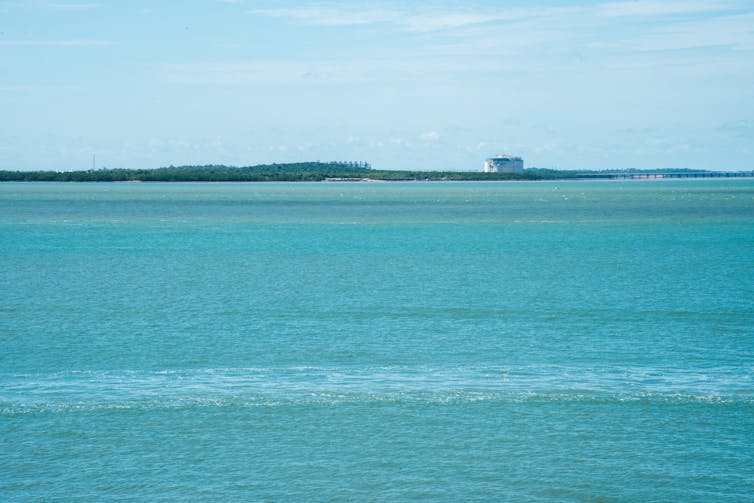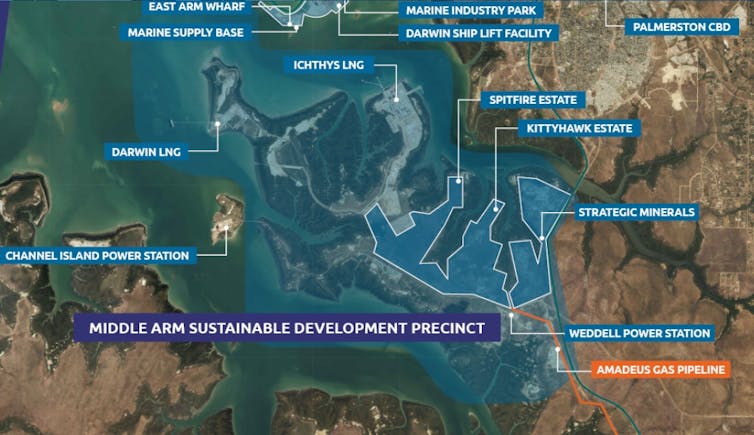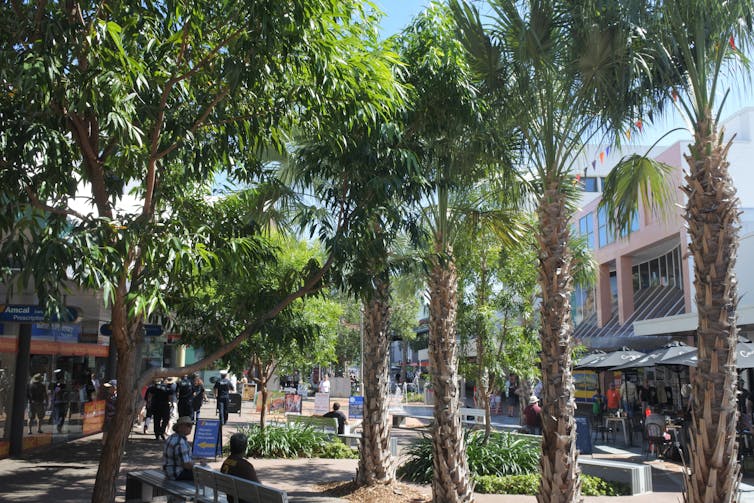A Senate inquiry has failed to reach agreement on whether the federal government should spend A$1.5 billion on a major industrial hub in Darwin – spending critics say amounts to a huge fossil fuel subsidy.
The project, known as the Middle Arm Industrial Precinct, involves developing a manufacturing and minerals hub on a peninsula at Darwin Harbour. The project would span about 1,500 hectares and include, among other infrastructure, the third liquified natural gas (LNG) export hub on the peninsula.
Traditional owners say the hub would damage Sea Country and cultural heritage. Other submissions to the inquiry raised concerns about threats to human health and wildlife, and the implications of expanding the gas industry in the midst of a climate crisis.
Despite the compelling evidence presented to the inquiry, committee members – who came from across the political spectrum – could not produce a unanimous set of recommendations. Labor must now decide whether to fund the Middle Arm precinct despite the weight of public concern.
I research environmental health, climate change, sustainability and Aboriginal and Torres Strait Islander health. I firmly believe this project should not proceed if it involves fossil fuels. It opens the door to serious environmental damage and suffering for Indigenous and non-Indigenous people alike.

What’s this all about?
The precinct requires clearing land and dredging the harbour to enable shipping. It also involves a new offloading facility, as well as roads, factories, jetties and pipelines. It would add a third LNG plant to those already at Middle Arm.
The site may also include a petrochemical manufacturing plant and a terminal to import carbon dioxide.
The NT government enthusiastically supports the development, which it describes as “sustainable”. It says the site would largely be powered by renewables and would support the hydrogen and carbon-capture industries.
In 2022, the Albanese government allocated $1.5 billion funding to the project. Announcing the spending, federal Infrastructure Minister Catherine King said the project would provide “a pathway to a decarbonised economy by helping emerging clean energy industries”.
The inquiry
A Senate inquiry into the spending began in September last year and attracted more than 200 written submissions.
In a report tabled in the Senate on Wednesday night, the inquiry committee said it had “not been able to reach agreement on a unanimous set of recommendations”.
Instead, the report presented a variety of views from crossbenchers, the Greens, the government and the opposition.
Government senators said the infrastructure at Middle Arm would support a range of activities, including green industries, and would help diversify the NT economy. The Coalition said it supports the precinct and claimed the inquiry failed to consider the economic benefits of the plan.
Greens senators said the precinct, as currently proposed, “will significantly expand the fossil fuel and fracking industries at a time when Australia’s economy requires rapid and dedicated efforts to decarbonise”.
Independent senator Lidia Thorpe said the wishes of the Larrakia people should be respected and the project should be scrapped, adding the spending should be allocated to projects that “promote the health of Country and its people”.
Fellow independent David Pocock said the plan “poses unacceptable risks to human health, the climate, biodiversity and cultural heritage”.
The views expressed by the Greens and independent senators reflect serious concerns raised about the project throughout the inquiry, which I outline below.

‘Eroding the spiritual essence of the land’
As part of the inquiry, Larrakia woman Mary Williams told a hearing in Darwin:
The Middle Arm precinct is not merely a piece of land; it’s our cultural heritage and traditional identity. Our ancestors have lived, hunted and performed sacred ceremonies on this land for countless generations, leaving behind a tapestry of history and wisdom.
The proposed development threatens to desecrate this sacred landscape, endangering culturally significant sites, disrupting ecological balance and eroding the spiritual essence of the land.
Similar feelings were expressed by the Directors of Nurrdalinji Aboriginal Corporation, representing Traditional Owners across the Beetaloo Basin.
Air pollution risks
Health risks associated with hazardous emissions occur at every step of gas production, processing and pipeline transport.
The Middle Arm precinct would be located just three kilometres from the fast-growing city of Palmerston and ten kilometres from central Darwin. These locations already experience poor air quality due to savanna burning.
Of the two gas plants already operating at the site, one is run by energy company Inpex. Since 2019, Inpex has reported annual emissions of the cancer-causing substance benzene. The annual emissions have exceeded – up to 22 times – the 500 tonnes the company predicted.
Inpex has also consistently released huge amounts of highly toxic substances including hydrogen sulphide, nitrogen oxides and volatile organic compounds.
Inpex also told the inquiry of long outages in devices at the site used to control pollution. In some cases, the controls were offline for weeks or months.
Alarmingly, a paper tabled by Pocock revealed a greatly increased risk of leukaemia among residents near petrochemical facilities, as well as other health concerns.
As Darwin paediatrician Louise Woodward wrote to the inquiry:
Our hospitals are struggling to cope with the burden of disease now. The Middle Arm development is likely to increase acute and chronic disease for a population which already has some of the worst health outcomes in the country.

Serious environmental threats
Scientists have warned the Middle Arm project threatens populations of endangered species and migratory shorebirds.
A submission by the Australian Marine Sciences Association warned dredging the harbour may mean heavy metals enter the marine food chain. In some cases, these metals can reach levels in fish and seafood that threaten human health.
Experts have also warned about the climate impact of the plan. Climate Analytics said Tamboran’s plans to extract gas from the Beetaloo Basin and produce it at Middle Arm would generate between 0.8 and 3.2 billion tonnes of CO₂-equivalent gases over the 25 years of the project, if the gas exported and burnt overseas was taken into account.
The precinct may also include a facility to import and store CO₂ and later bury it underground. Such technologies are speculative and plagued with problems, including in Australia.
No time to gamble
The ball is now in the federal government’s court. While the Senate committee did not reach a unanimous decision on the $1.5 billion spending, evidence presented to the inquiry raises deep questions about the plan.
Australian taxpayers should not be funding a project that gambles with human health and that of the environment.
The Middle Arm industrial hub should not proceed with fossil fuel industries. True leadership on this issue is needed urgently – for the sake of current and future generations.
In the past, Melissa Haswell has received research funding from the National Health and Medical Research Council, the National Suicide Prevention Strategy, FACSIA, Red Cross, Australian Health Ministers Advisory Council Priority Driven Research, Queensland Health and Queensland Department of Environment and Science. Melissa Haswell is a member of the Public Health Association Australia, Climate and Health Alliance, Sydney Environment Institute and the International Society for Environmental Epidemiology. She has attended some meetings of a community independent movement in the electorate of Dickson.
This article was originally published on The Conversation. Read the original article.







